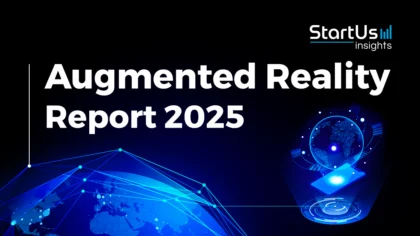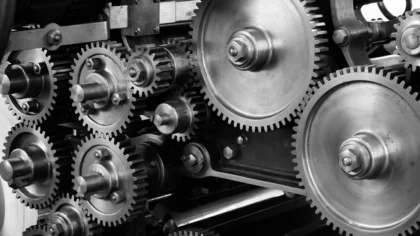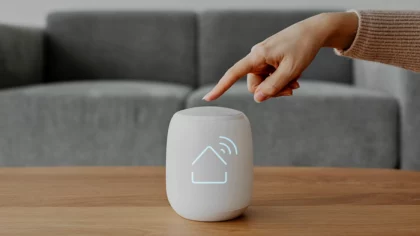Accelerate Productivity in 2025
Reignite Growth Despite the Global Slowdown
Advances in the HVAC (heating, ventilation, and air conditioning) sector are transforming the way people manage indoor environments. The integration of smart technologies enables users to adjust temperature, humidity, and air quality settings from anywhere. Intelligent systems also employ sensors and data analytics to optimize energy efficiency while reducing costs and environmental impact. Further advancements in predictive maintenance improve system reliability and optimize operational expenditures.
Top 10 HVAC Industry Trends (2025)
- Connected HVAC
- Predictive Maintenance
- Precision Indoor Climate Control (PICC)
- Renewable Integration
- Ductless HVAC
- Energy Recovery Ventilation
- Energy Analytics & Management
- Noise Reduction Technologies
- Immersive Assistance & Training
- Green Refrigeration
Methodology: How We Created the HVAC Trend Report
For our trend reports, we leverage our proprietary StartUs Insights Discovery Platform, covering 5M+ global startups, 20K technologies & trends plus 150M+ patents, news articles, and market reports.
Creating a report involves approximately 40 hours of analysis. We evaluate our own startup data and complement these insights with external research, including industry reports, news articles, and market analyses. This process enables us to identify the most impactful and innovative trends in the HVAC industry.
For each trend, we select two exemplary startups that meet the following criteria:
- Relevance: Their product, technology, or solution aligns with the trend.
- Founding Year: Established between 2020 and 2025.
- Company Size: A maximum of 200 employees.
- Location: Specific geographic considerations.
This approach ensures our reports provide reliable, actionable insights into the HVAC innovation ecosystem while highlighting startups driving technological advancements in the industry.
Innovation Map outlines the Top 10 Trends in HVAC & 20 Promising Startups
For this in-depth research on the Top HVAC Trends & Startups, we analyzed a sample of 650+ global startups & scaleups. The HVAC Innovation Map created from this data-driven research helps you improve strategic decision-making by giving you a comprehensive overview of the HVAC industry trends & startups that impact your company.
Tree Map reveals the Impact of the Top 10 HVAC Technology Trends
Based on the HVAC Technology Innovation Map, the Tree Map below illustrates the impact of the Top 10 HVAC Industry Trends in 2025. Connected HVAC solutions integrate with smart home devices for better control and efficiency. Predictive maintenance uses AI to detect system failures early, reducing downtime and costs. Renewable energy sources, like solar and wind power, promote sustainability by reducing reliance on fossil fuels and lowering emissions. ERV systems recover waste heat to improve energy efficiency and reduce costs. Energy analytics tools provide detailed energy use insights for optimized HVAC performance and reduced consumption.
Global Startup Heat Map covers 683 Emerging HVAC Companies
The Global Startup Heat Map showcases the distribution of 650 exemplary startups and scaleups analyzed using the StartUs Insights Discovery Platform. It highlights high startup activity in Western Europe, followed by the East Coast US and India. From these, 20 promising startups are featured below, selected based on factors like founding year, location, and funding.
Want to Explore HVAC Innovations & Trends?
Top 10 HVAC Trends in 2025
1. Connected HVAC
Energy inefficiency, suboptimal temperature control, and limited maintenance capabilities are the common challenges of traditional HVAC systems. IoT connects HVAC systems to a network and enables remote monitoring and control.
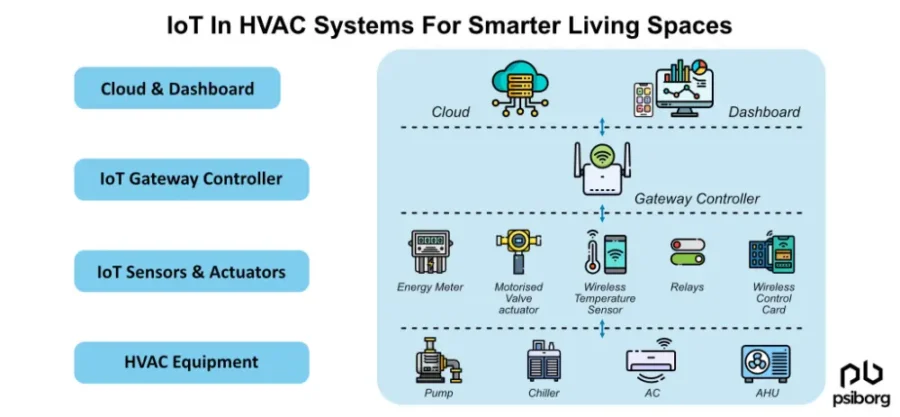
Credit: PsiBorg
Additionally, smart thermostats and sensors provide real-time data on temperature, humidity, and system performance. This facilitates precise adjustments and optimization.
Retrofit solutions also play a crucial role in this transformation as they mitigate infrastructure overhaul in connecting HVAC networks to the internet. Through IoT connectivity and smart devices, connected HVAC systems improve performance and reduce operational costs.
Sobie Systems enhances Furnace Health Management
Canadian startup Sobie Systems makes an IoT-based HVAC sensing solution that operates 24/7. Its product, K2, connects to furnace boards and delivers real-time health measurements.
Moreover, Sobie Systems provides an efficient management tool for HVAC service teams and enhances asset repair scheduling.
Sensgreen enables Remote HVAC System Management
UAE-based startup Sensgreen develops an IoT platform that transforms buildings into smarter healthier environments. The startup’s technology controls and monitors various aspects of HVAC, such as radiators, air conditioners, and plugs, using LoRaWAN-based devices.
These devices include thermostatic radiator valves, air conditioner controllers, and plug controllers that support remote management and smart control. The platform also provides AI-based reports for optimizing HVAC management strategies and automating building controls.
2. Predictive Maintenance
Airflow imbalances, refrigerant leaks, clogged filters, and malfunctioning components make HVAC maintenance challenging. These issues result in reduced efficiency, higher energy consumption, and compromised air quality, increasing maintenance costs.
Predictive maintenance platforms leverage sensors, data analytics, and machine learning algorithms to spot early warning signs of HVAC failures or inefficiencies. This allows technicians to schedule timely repairs or maintenance activities before major breakdowns occur.
Predictive maintenance, in this way, streamlines HVAC maintenance while minimizing downtime and energy consumption. It also extends the overall lifespan of the system, resulting in cost savings and improved comfort for building occupants.
Moreover, the HVAC maintenance service market size was valued at USD 72.96 billion in 2023. It is projected to reach USD 138.95 billion by 2032, growing at a CAGR of 7.42% from 2024 to 2032.
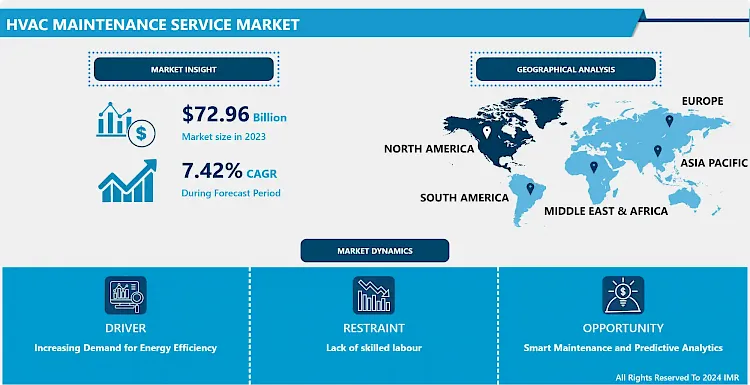
Credit: Introspective Market Research
MechaSense enables Proactive HVAC Maintenance
US-based startup MechaSense provides intelligent monitoring for building systems, specifically HVAC units. The startup’s technology collects key parameters from HVAC assets and securely transmits this data to its IoT cloud.
The system then processes the information and detects operational issues, enabling proactive maintenance and the prevention of critical failures. The platform also provides alerts and actionable insights on potential malfunctions, reducing energy consumption and maintenance costs.
Carnot Innovations simplifies Equipment Failure Detection
Carnot Innovations from Hong Kong develops an AI-powered analytics platform for HVAC systems. The startup’s platform collects data from existing sensors and IoT devices as well as manages and visualizes this data. It then optimizes energy consumption and predicts maintenance needs.
The platform’s machine learning models identify abnormal data deviations and offer prescriptive insights for facility managers. Carnot Innovations’ solutions enable the detection of unnoticed equipment faults in conventional building management systems (BMS), decreasing energy consumption and avoiding expensive replacements.
3. Precision Indoor Climate Control
Temperature fluctuations, poor humidity control, uneven air distribution, and limited individual customization options negatively impact occupants’ comfort and productivity. Digital monitoring and management tools simplify the adoption of precision indoor climate control solutions. Such systems utilize advanced sensing, data analytics, and algorithms to deliver precise and personalized climate control in each zone or even at an individual level within a building.
By continuously monitoring and adjusting temperature, humidity, and airflow parameters, PICC systems ensure that occupants experience consistent comfort. They also adapt to changes in occupancy, weather conditions, and building usage patterns, optimizing energy efficiency and lowering operating costs. HVAC systems utilizing these solutions offer a tailored and comfortable indoor environment to enhance occupant satisfaction and well-being.
Virens enables Occupancy-based HVAC Control
UK-based startup Virens develops a data-driven property management solution that optimizes building energy consumption patterns. The startup’s interactive HVAC control solution leverages proprietary radar motion sensors to capture user activity and occupancy within a building.
This information interacts with the building’s HVAC system to optimize its performance based on occupancy, providing an efficient and privacy-driven alternative to image-based CCTVs. Virens’ solutions digitize and automate building climate control while enabling precise control for energy savings. This allows building managers to achieve the goal of net zero buildings.
Ti-DOX develops Air Cleaner Technology
Ti-DOX, a Canadian startup, offers the HydroxylizAire device, an air decontamination system that integrates seamlessly with centralized forced air ventilation. It neutralizes chemicals and pathogens, and by reducing radon and smoke.
This promotes a healthier indoor environment. The device combines UVC light with a titanium dioxide coating to generate hydroxyl radicals, making it ideal for spaces with respiratory or chemical sensitivity concerns.
4. Renewable Integration
With the increasing demand for energy efficiency and the need to reduce emissions, the integration of renewable energy sources into HVAC systems has become a key focus for sustainable building practices. This shift towards renewable energy mitigates the environmental impact of buildings and helps achieve energy independence.
By harnessing renewable energy, such as solar power or geothermal energy, HVAC systems significantly reduce their carbon footprint. Additionally, advanced control systems optimize the utilization of renewable energy, matching it with the heating and cooling demands of the building. This integration reduces the reliance on coal and also helps achieve stronger energy efficiency targets and cost savings, contributing to a more sustainable future.
Further, the renewable energy integration systems market size will grow to USD 212.42 billion in 2029 at a CAGR of 9.5%. It is expected to see strong growth in the next few years.

Credit: The Business Research Company
GeoAirCon offers Geothermal Heating & Cooling
Pakistani startup GeoAirCon develops ground-sourced climate control technology. This technology leverages temperate underground temperatures and reduces climate control and air-conditioning costs.
Its components include a coil fin unit, HDPE piping, circulation pump, and in-line chiller system. Further, GeoAirCon’s heat exchange technology has applications in industrial, commercial, residential, and agricultural uses.
Heliostorage provides Seasonal Thermal Storage
Finnish startup Heliostorage offers a seasonal thermal energy storage solution that efficiently heats buildings. The startup’s technology combines solar thermal collectors, a smart thermal controller, and a proprietary borehole thermal energy storage (BTES).
It collects the excess during spring and summer to store it in BTES for utilization in colder months. The system also supports other sources of heat like industrial waste heat or excess district heating. Its smart controller further monitors all heat flows and directs heat as necessary, ensuring the desired efficiency throughout the year.
5. Ductless HVAC
The ductless HVAC system market size is expected to reach nearly USD 16.93 billion by 2030, growing at a CAGR of 8.18% from 2024 to 2030.
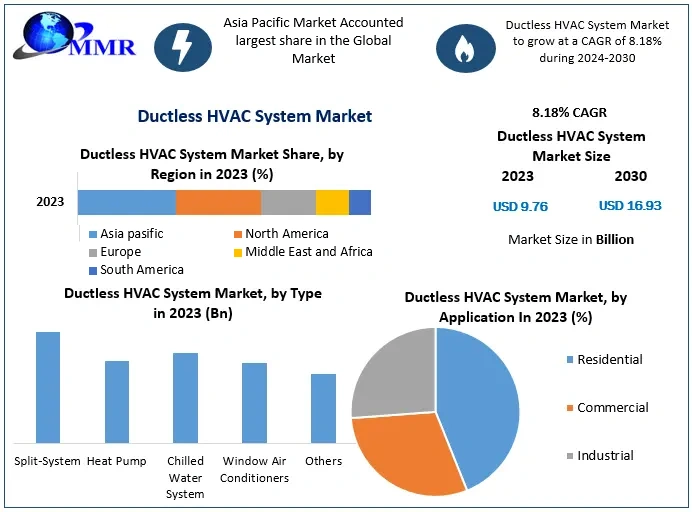
Credit: Maximize Market Research
HVAC systems often face challenges related to the design and installation of ductwork, which are costly, time-consuming, and space-consuming. Ductwork also introduces a source of energy loss and inefficiency due to frequent leaks and poor insulation.
Ductless HVAC, also known as mini-split systems, provides an alternative approach by eliminating the need for ductwork altogether. Instead, individual air handling units are installed in each room or zone, connected to an outdoor condenser unit. This allows for independent temperature control and zoning, ensuring personalized comfort and energy savings.
Further, ductless HVAC systems are highly efficient as they eliminate duct-related losses and can be equipped with advanced features such as variable-speed compressors and motion sensors. The absence of ducts also simplifies installation, diminishes maintenance requirements, and improves indoor air quality by eliminating dust and allergen buildup.
Quilt manufactures a Ductless Heat Pump
US-based startup Quilt makes an intelligent ductless heat pump system for residential buildings. The startup’s solution features AI-driven efficiency and room-by-room management functionalities for home heating and cooling applications.
As a result, Quilt’s ductless electric pump enhances energy efficiency while avoiding fossil fuel utilization.
Gradient offers Compact Window Air Conditioners
US-based startup Gradient provides a ductless HVAC solution that combines heating and cooling in a single system. Its simple-to-set-up modular design places the power and noise outside the window, leaving only the heating and cooling for a calm room environment.
Gradient’s commercial-grade heat pump technology enables more efficient operation than traditional window air conditioning units while reducing energy consumption.

6. Energy Recovery Ventilation
Conventional HVAC systems frequently experience certain energy loss as fresh air is introduced and stale air is exhausted. This energy loss leads to increased energy consumption. Developments in ERV systems mitigate this loss by recovering and exchanging heat or coolness between the incoming and outgoing air streams.
The heat exchanger in ERV systems allows for the transfer of thermal energy, decreasing the need for additional heating or cooling. This enhances energy efficiency and also helps maintain a consistent and comfortable indoor environment.
Moreover, ERV systems facilitate the exchange of moisture and pollutants, improving indoor air quality by balancing stale and fresh air. By incorporating energy recovery ventilation into HVAC systems, buildings significantly reduce energy consumption, lower operating costs, and ensure a more comfortable indoor atmosphere.
Further, the global energy recovery ventilator market is projected to grow at a CAGR of 14.3% from 2023 to 2031, reaching USD 9.8 billion by 2031.
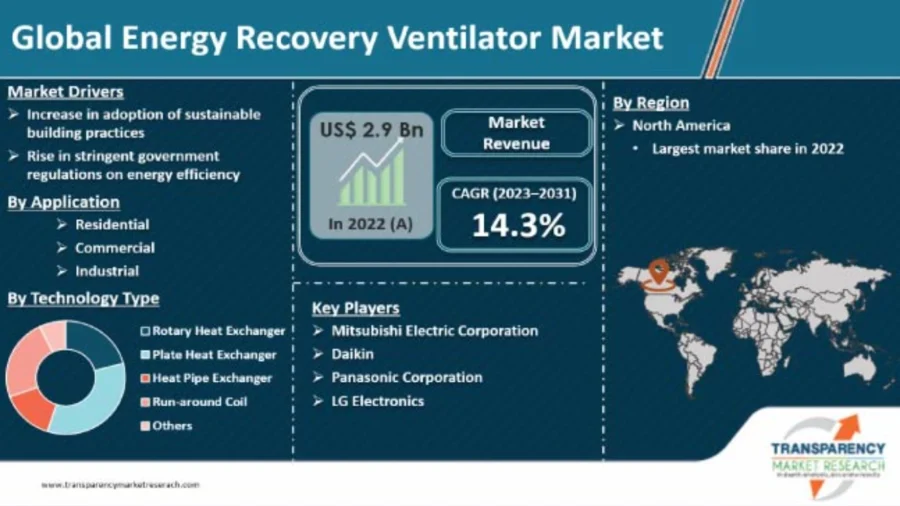
Credit: Transparency Market Research
TCPoly develops Heat Recovery Panels
US-based startup TCPoly manufactures heat recovery and thermal energy storage products to increase the efficiency of commercial ventilation systems. XPanel is the startup’s energy recovery ventilation system that enables high-efficiency heat and moisture transfer between the building in-take and exhaust airstreams.
The panel utilizes TCPoly’s proprietary materials and 3D printing process to achieve optimal performance and minimal installation expenditures. It recovers a large portion of the energy from exhaust air streams without any moving parts or complicated maintenance schedules. As a result, TCPoly’s smart technology allows users to monitor their system and quantify savings, making it ideal for energy efficiency and cost reduction in commercial buildings.
Hydronic Shell improves Building Efficiency
US-based startup Hydronic Shell provides a prefabricated and modular assembly solution for HVAC. The startup’s system conditions buildings from the outer shell with heating and cooling radiating through the existing facade.
The solution operates with high efficiency, providing improved energy balance, indoor air quality, thermal comfort, and return on investment (ROI). Besides, the startup integrates an energy recovery wheel to reduce loads and energy consumption. By turning the existing masonry facade into a thermal storage battery, the startup enhances building resilience and allows for demand response during peak events.
7. Energy Analytics & Management
The inefficient operation, lack of visibility into energy usage, and difficulties in identifying and addressing system inefficiencies are some of the issues associated with HVAC management. Energy analytics and management solutions offer effective means to solve these problems.
By leveraging advanced sensors, data analytics, and machine learning algorithms, energy analysis solutions collect and analyze information from HVAC systems in real time. This enables building operators and facility managers to gain insights into energy consumption patterns, identify energy-saving opportunities, and spot system inefficiencies or malfunctions.
These energy management systems also act as prerequisites for implementing energy-saving strategies, such as adjusting setpoints, scheduling operations, and streamlining equipment runtime. Additionally, energy analytics and management solutions provide ongoing monitoring and performance tracking, enabling proactive maintenance and continuous refinement of HVAC system efficiency.
Articae provides an HVAC Energy Management Platform
Spanish startup Articae develops an energy management platform that enhances sustainability and energy efficiency in industrial and commercial HVAC systems. PilotE² EMS is the startup’s platform that processes raw data from energy measurements to generate comprehensive reports on energy and economic indicators.
It also allows users to track the evolution of energy consumption in their facilities, including electricity, gas, and water. The insights gained from these reports enable energy-saving actions that further reduce the carbon footprint of HVAC systems.
Nrlyze aids Energy Balancing
Swedish startup Nrlyze creates an IoT-based solution to reduce energy consumption in real estate by correcting imbalances and incorrect settings in heating installations. It leverages AI-based algorithms to analyze, identify, and correct the issues with HVAC.
This includes balancing temperature differences between apartments, optimizing heating systems for a consistent indoor climate, and providing real-time, fact-based decisions about necessary measures. The startup’s wireless connected sensors utilizing proprietary mesh technology facilitate easy installation and monitoring. Nrlyze also offers a performance tracking feature to compare consumption before and after efficiency measures.
8. Noise Reduction Technologies
Noise issues in HVAC systems arise from various sources, including fans, compressors, air handlers, and ductwork. Excessive noise levels lead to decreased productivity, disturbed sleep, and overall dissatisfaction among occupants. Contemporary noise reduction technologies focus on minimizing noise at its source, improving sound insulation, and implementing sound control measures.
Startups and scaleups develop advanced fan blade designs and motors to reduce fan noise. Further, sound-dampening materials and acoustic enclosures also attenuate noise from compressors and air handlers.
Additionally, vibration isolation techniques and duct lining materials help diminish noise transmission through the ductwork. In effect, such solutions aid HVAC systems to operate more quietly and provide a peaceful indoor setting for building occupants.
Also, the noise absorbing air intake duct market size is expected to reach USD 625 million by 2027, growing at a CAGR of 4.2% during the forecast period, 2020-2027.
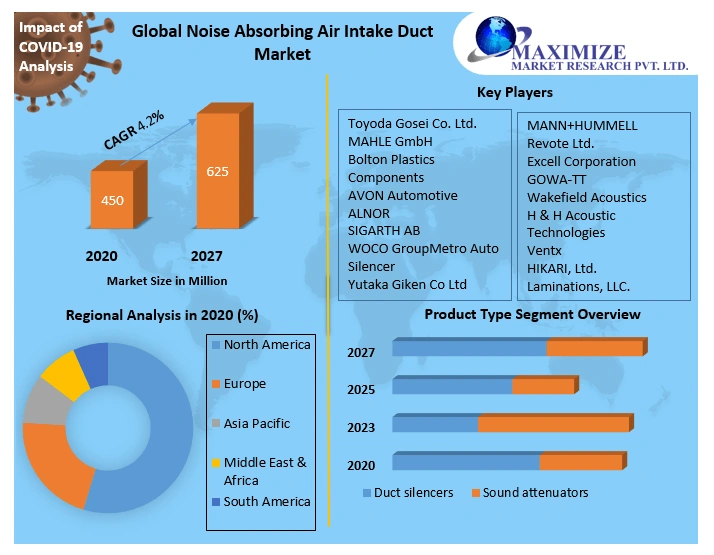
Credit: Maximize Market Research
Redu-Sone develops Duct Silencers
Dutch startup Redu-Sone makes passive noise control solutions using micro-perforated plate/panel (MPP) technology. The startup’s MPP-based duct silencers reduce noise emissions using mathematical optimization models. Its silencers are suitable for various markets, including HVAC, racing, chimney systems, and the food industry.
Moreover, Redu-Sone’s silencers are fire-proof, long-lasting, recyclable, as well as less prone to contamination. They also do not obstruct gas flow, resulting in low pressure drop. This altogether assists building developers with dampening HVAC noise without prominent energy loss.
Reducd creates Custom Noise Enclosures
Reducd is a Dutch startup that develops noise-reducing enclosures for (hybrid) heat pumps and air conditioners. The startup’s enclosures use Magnelis, a high-quality galvanized steel coating, and offer finishing in any RAL color to match the building style.
The enclosures are durable and focus on sustainability using recycled content.
9. Immersive Assistance & Training
Improper maintenance practices lead to increased energy consumption and costly repairs of HVAC systems. Immersive assistance utilizes augmented reality (AR) and virtual reality (VR) to deliver interactive and hands-on guidance for HVAC technicians. AR overlays digital information, such as repair instructions or equipment diagrams, onto the real-world HVAC system for technicians to troubleshoot and fix problems more efficiently.
VR-based training programs offer simulated environments where technicians practice HVAC maintenance procedures and gain practical experience in a risk-free setting. These immersive technologies enhance the learning and troubleshooting capabilities of personnel, leading to quicker and more accurate diagnosis and repair of HVAC issues. This, in turn, ensures effective maintenance, minimizes downtime, reduces costs, and improves overall system performance.
Supporteo enables Assisted HVAC Maintenance
US-based startup Supporteo offers an AR solution for the frontline workforce in the HVAC industry. The startup’s AR-based solution simplifies regular inspections and maintenance work, eliminating the need for complex manuals. It provides precise and focused inspections with checklist-based reviews, guided diagnostics, troubleshooting, and automatic process documentation.
Supporteo also offers real-time collaboration through video calls for complex tasks that require expert consultation. These experts assist field technicians remotely and monitor the process through the technicians’ headsets. This reduces the chance of failure caused by human errors, leading to overall quality improvement and workload reduction.
HomeX delivers Virtual Assistance for HVAC Maintenance Training
US-based startup HomeX provides virtual assistance solutions to tackle problems in the home services industry, with a particular focus on HVAC applications. The startup’s Live Expert Help and Diagnostic Software Platform combine visual assistance, diagnostic intelligence, and access for expert laborers to remotely diagnose and resolve home issues.
HomeX’s technology empowers experienced technicians to deliver enhanced diagnostics at scale, complementing existing workflows. The platform also generates detailed diagnostic reports that provide meaningful information before in-home visits. This improves customer experience, reduces truck rolls, minimizes operational burden and cycle time, as well as lowers training and support costs.
10. Green Refrigeration
The global eco-friendly refrigerants market is expected to grow at a CAGR of 7.8% from 2024 to 2030, reaching USD 30.79 billion by 2030.
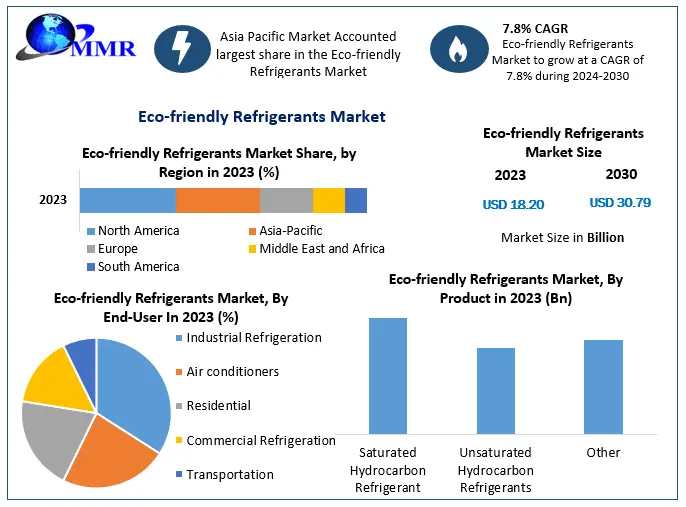
Credit: Maximize Market Research
Traditional refrigerants, such as hydrofluorocarbons (HFCs), have a relatively high global warming burden potential. To take on this challenge, the HVAC industry is adopting green refrigeration technologies. Green refrigeration is usually driven by alternative cooling techniques and eco-friendly approaches.
One such alternative technique is magnetic cooling, which relies on the magnetocaloric effect to achieve cooling without the need for traditional refrigerants. Magnetic cooling involves applying a magnetic field to a solid material, causing it to heat up, and then removing the magnetic field to allow the substance to cool down.
By leveraging magnetic cooling and other alternative cooling techniques, HVAC systems shrink their reliance on harmful refrigerants, minimizing environmental impact.
Magnoric makes Magnetic Cooling Systems
Magnoric is a French startup that specializes in magnetocaloric technology for cooling, air conditioning, and energy conversion. It uses the magnetocaloric effect and a simple, non-toxic, water-based coolant to capture the temperature differential, as well as deliver clean and efficient cooling.
In addition to cooling, Magnoric is developing devices to exploit temperature differential changes to efficiently convert low sources of waste heat into electricity. The technology is reliable, durable, silent, low in vibrations, and free from constraining gas regulations. By avoiding the use of refrigerant gas, the startup reduces the impact of HVAC systems on global warming.
Magnotherm offers Magnetic Heating & Cooling
German startup Magnotherm develops magnetocaloric technology for cooling and heating applications. The startup’s technology has zero global warming potential (GWP), ozone depletion potential (ODP), and direct CO2 emissions. It operates at low pressures, thus resulting in low vibrations, nearly noise-free operation, and low maintenance.
The startup’s units also have the capability to scale to specific temperatures and power ranges without loss in efficiency. Further, with minor changes, the technology functions as a highly efficient heat pump. The startup thus offers heating and cooling with a low or zero carbon footprint.
Discover all HVAC Technology Trends & Startups
Digital innovations in the HVAC sector deliver better visibility into operational aspects, reducing energy consumption and avoiding sudden failures. Geothermal heat pumps and solar-powered air conditioning also decrease the carbon footprint of HVAC systems.
Further, the use of biodegradable and non-toxic refrigerants aid in addressing environmental concerns related to traditional refrigerants. As such, the future of HVAC sector innovation lies in a convergence of smart technology, green energy solutions, and user-friendly interfaces.
The Trends in HVAC & Startups outlined in this report only scratch the surface of trends that we identified during our data-driven innovation & startup scouting process. Identifying new opportunities & emerging technologies to implement into your business goes a long way in gaining a competitive advantage.
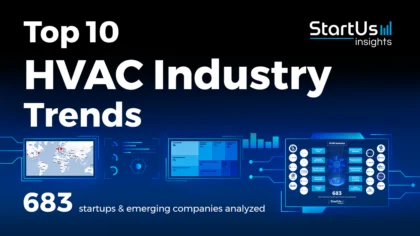

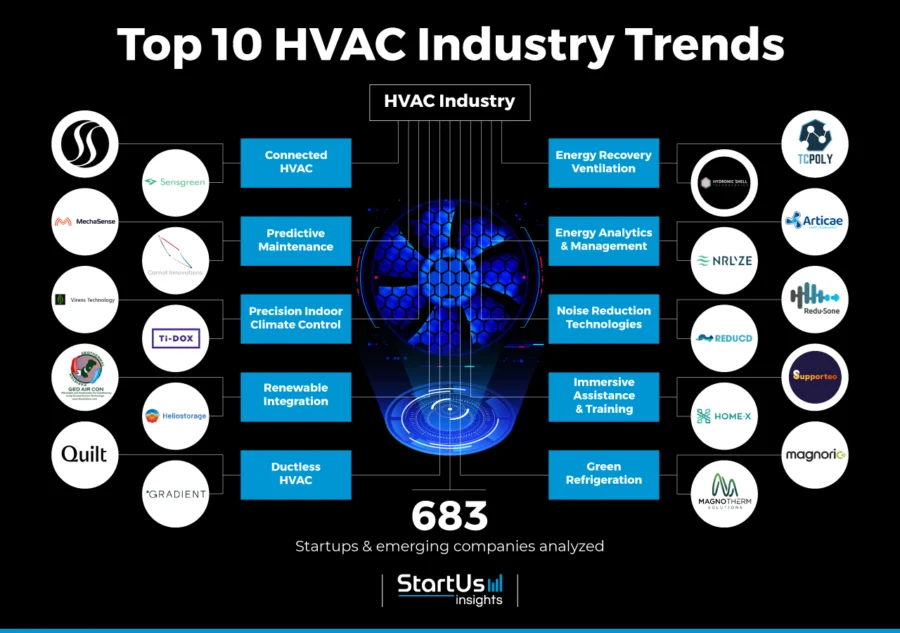
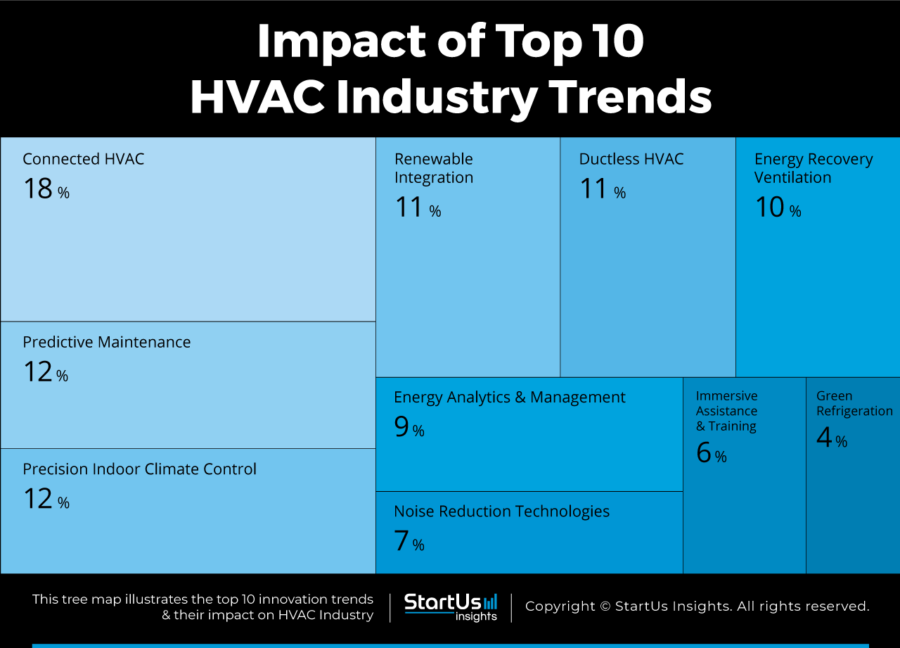


![10 Top Digital Twin Startups and Companies for Industry 4.0 [2025]](https://www.startus-insights.com/wp-content/uploads/2025/06/Digital-Twin-Startups-for-Industry-4.0-SharedImg-StartUs-Insights-noresize-420x236.webp)
